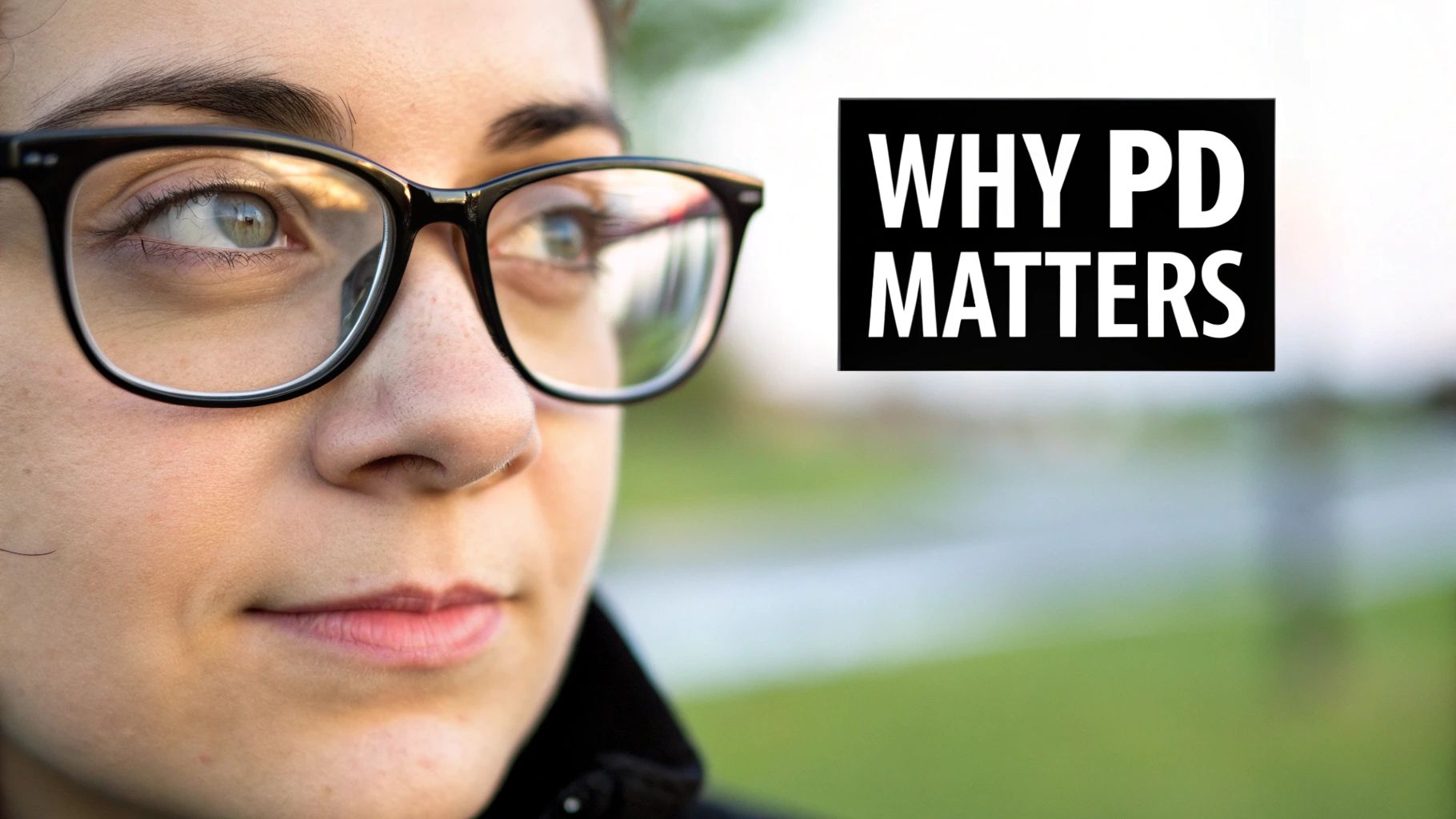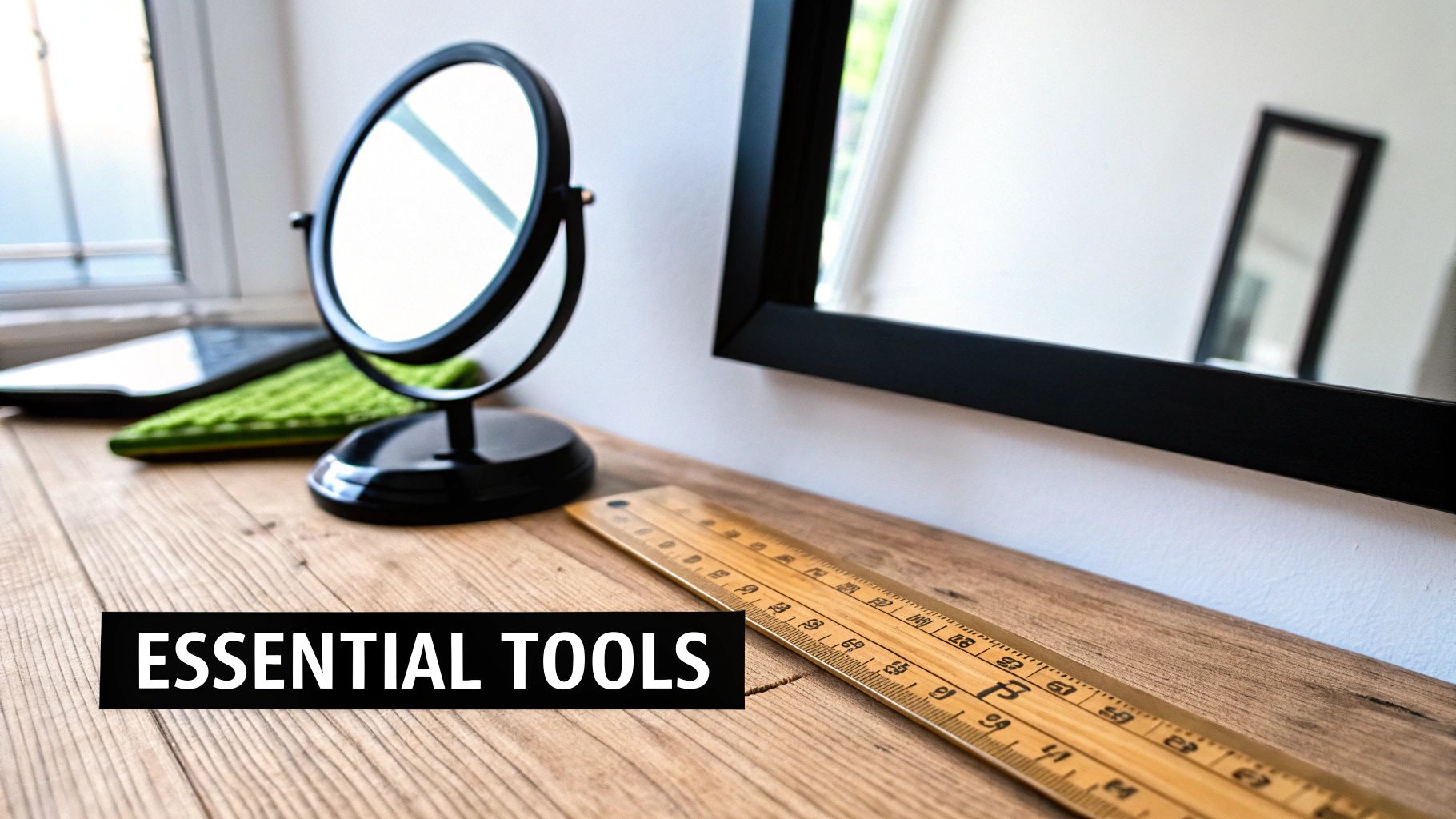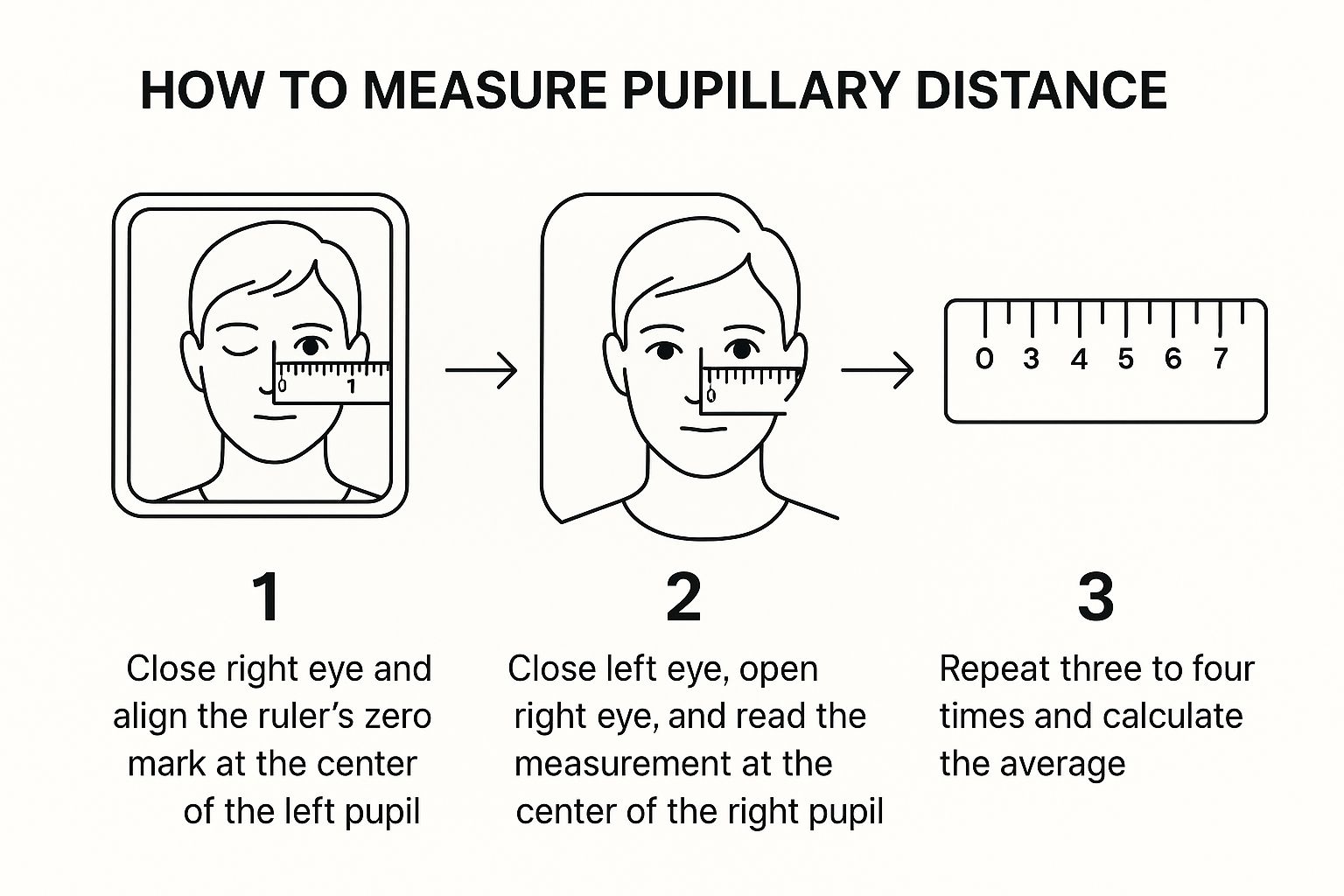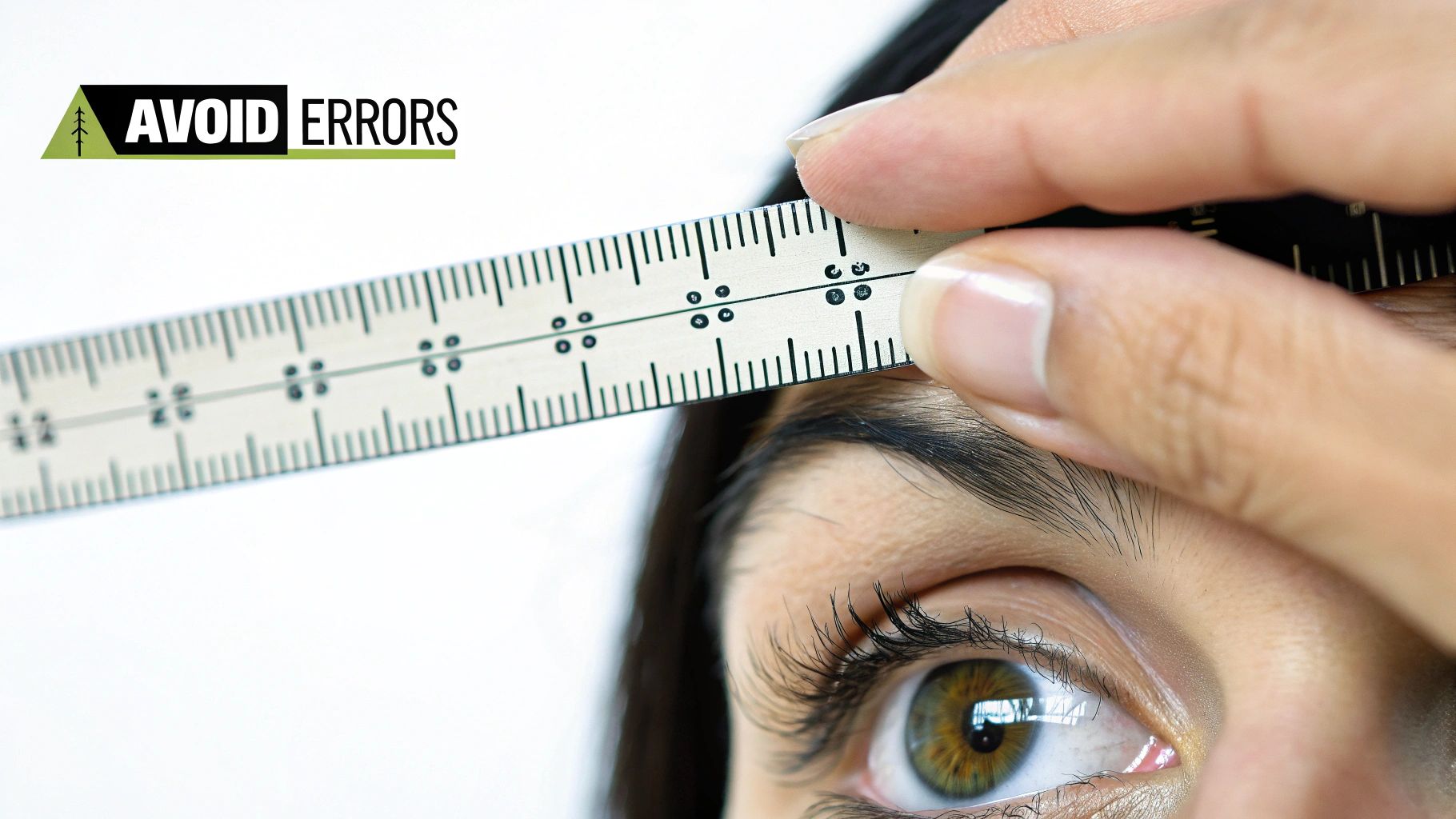Measuring your pupillary distance (PD) is surprisingly straightforward: it's just the distance in millimetres between the centres of your pupils. Getting this number right is the secret to making sure your prescription lenses are perfectly aligned for your eyes. An accurate PD is a critical part of ensuring eye health and safety, guaranteeing your new glasses will give you sharp, comfortable vision right from the get-go.
Why An Accurate Pupillary Distance Is Non-Negotiable For Your Vision

Before you even think about reaching for a ruler, it’s vital to understand why this measurement isn’t just a nice-to-have—it’s absolutely critical for your eye health. Think of your PD as the unique blueprint for your eyes. When you order glasses, this number dictates that the optical centre of each lens is placed directly in front of your pupil.
It’s a bit like trying to look through a pair of binoculars. If the eyepieces are set too wide or too narrow, the image is distorted and confusing. An incorrect PD in your glasses creates the exact same problem, forcing your eyes to strain just to see clearly. This constant misalignment is a direct threat to your visual comfort and can lead to some really unpleasant side effects.
The Downside of an Incorrect Measurement
A PD that's even a few millimetres off can introduce a whole host of issues that impact your daily comfort and vision. These problems can creep up on you, making it tough to figure out what's causing them and putting your eye health and safety at risk.
Common signs of an incorrect PD include:
- Nagging Headaches: Especially those that pop up after reading or spending time on the computer.
- Noticeable Eye Strain: That tired, overworked feeling in your eyes.
- Blurry or Distorted Vision: Things just don't seem as crisp as they should, particularly around the edges of your lenses.
Imagine your true PD is 63mm, but your glasses were made for a 60mm PD. Your eyes are constantly fighting to look slightly inwards to find the "sweet spot" of the lens. That continuous effort is a fast track to visual fatigue and discomfort. For a full rundown on what you need to order specs, check out our guide to buying prescription glasses online.
Key Takeaway: A precise PD isn't just about comfort—it's fundamental to your eye health. It ensures your prescription lenses do their job properly, giving you the clearest vision possible without any unnecessary strain.
Single PD vs Dual PD
You might come across your PD written in two different ways: as one number, or as two.
A single PD is simply the total distance from the centre of one pupil to the centre of the other. For many people, this single measurement works just fine. However, for the most accurate fit—especially with more complex prescriptions—a dual PD is the gold standard.
A dual PD measures the distance from each pupil to the bridge of your nose separately (for example, 31.5/32.5). This is absolutely essential for multifocal lenses like bifocals or progressives, where lens accuracy is paramount. Because our faces are rarely perfectly symmetrical, this two-number approach guarantees each lens is perfectly centred over its corresponding eye.
Here in Australia, optometrists rely on precise tools to get these readings spot on. For instance, local research shows the average PD varies by gender, with men typically having a wider PD (around 62.5 mm) than women (60.4 mm). This really drives home why a personalised, accurate measurement is crucial for proper lens placement and comfort. No matter your individual needs, we can customize an eye wear package to suit your requirements.
The Simple Tools You Need to Measure Your PD

You don't need any fancy, high-tech equipment to get a solid PD measurement at home. The good news is you probably have everything you need lying around already. Getting your tools together is the first real step in figuring out your pupillary distance.
All you really need are two basic items: a ruler with millimetre markings and a mirror. That’s it. With just these two things, you can get an accurate reading and make sure your new lenses are perfectly lined up with your eyes.
Choosing Your Measurement Tools
When it comes to the ruler, accuracy is everything. A flexible tailor's tape is a great option because it can curve nicely along your brow, but any straight ruler is perfectly fine as long as it clearly shows millimetres (mm). Don't try to use a ruler that only has centimetres or inches—you'll end up guessing with conversions, which can lead to a bad measurement and some serious eye strain later.
For a solo measurement, a mirror is your best mate. Your bathroom mirror is usually a good bet since it's large and the lighting is decent. Stand about 20-30 centimetres away, which is roughly an arm's length. This keeps you close enough to read the ruler but far enough that your eyes aren’t straining to focus.
Get a Friend to Help for Better Accuracy
While you can absolutely do this on your own, grabbing a friend can make the whole process that much more precise. Having someone else look at the ruler head-on is the best way to avoid a common mistake called parallax error.
This little distortion happens when you look at a measurement from an angle, making the reading appear to shift. To get a spot-on PD, the person helping you needs to be at the same eye level, looking straight at the ruler.
If you do get a hand, ask your friend to sit or stand directly in front of you, making sure you're both at the same eye level. It might seem like a small detail, but it’s a crucial part of Eye Health and Safety. A correct measurement prevents the headaches and blurry vision that come from poorly aligned lenses.
Taking the time to get this right now means the custom eyewear we put together for you will be a perfect fit.
Measuring Your Pupillary Distance with a Ruler and Mirror
Alright, let's get down to the practical part. Learning how to measure your own pupillary distance is a surprisingly simple skill, and it puts you right in the driver's seat when ordering glasses online. All you really need is a millimetre ruler and a mirror to get a reliable reading.
The goal here is simple: measure the distance from the centre of one pupil to the centre of the other. Let's walk through exactly how you can do this at home, accurately and safely.
The Self-Measurement Technique
First things first, find a well-lit spot in your house and stand about an arm's length from a mirror.
Grab your ruler (one that measures in millimetres) and hold it flat against your brow. You'll want to keep it super steady, so try bracing your hand against your forehead to stop it from shifting around during the measurement.
Ready? Start by closing your right eye. Carefully line up the '0' mark on the ruler with the absolute centre of your left pupil. Look closely. Once you've got it perfectly aligned, freeze—don't move that ruler an inch.
Now, while keeping the ruler perfectly still, close your left eye and open your right. Take a look. The number that lines up with the centre of your right pupil is your pupillary distance. It's a straightforward trick that gets the job done.
This infographic breaks down the process visually.

As you can see, the secret to an accurate reading is all about keeping that ruler completely stationary while you switch eyes. Any little movement can throw the number off.
Getting a Friend to Help
For an even more precise result, grabbing a friend can make a world of difference.
Ask them to sit directly across from you, making sure you're both at the same eye level. This is really important for both Eye Health and Safety, as it helps avoid something called parallax error—that's when a measurement looks different depending on the angle you're viewing it from.
Your friend will hold the ruler steady against your brow while you look straight ahead, focusing on an object in the distance. Then, they'll just need to:
- Align the '0' mark with the centre of one of your pupils.
- Read the measurement that lines up perfectly with the centre of your other pupil.
- Their direct, head-on view helps ensure the reading is spot-on.
It's crucial to remember that PD isn't a one-size-fits-all number. To give you a bit of context, we've put together a table of common PD ranges you'll find here in Australia.
Common Pupillary Distance Ranges in Australia
This table provides typical PD ranges for adults in Australia, helping you verify if your measurement is within a normal scope. Note that these are averages and individual measurements can vary.
| Group | Typical PD Range (in millimetres) |
|---|---|
| Women | 46mm – 65mm |
| Men | 59mm – 74mm |
Seeing these ranges really highlights why a personal measurement is so vital. It’s the only way to ensure the optical centre of your lenses aligns perfectly with your pupils for that crisp, comfortable vision we're all after. You can dive deeper into pupillary distance averages and their importance on specsavers.com.au.
A Pro Tip for Precision: Whether you're flying solo or have a helper, repeat the measurement three or four times. This smooths out any tiny movements or inconsistencies. Once you have a few readings, just calculate the average to lock in the most accurate number.
And what if your measurement lands between two lines? No stress. Just round up to the nearest half-millimetre. For example, if you measure somewhere between 62mm and 63mm, you'd jot it down as 62.5mm.
By taking your time and following these steps, you can confidently measure your PD. This accurate number is the critical first step for us to create a pair of glasses that are perfectly customised for you.
Using Apps and Digital Tools to Find Your PD
If you'd rather skip the ruler and go for a more modern approach, there are plenty of digital tools you can use right on your smartphone. These apps are a super convenient way to measure your pupillary distance, and it usually only takes a minute or two.
Most of these apps work in a similar way: they use your phone’s camera to snap a photo or a quick video of your face. To get the scale right, they’ll ask you to hold a standard-sized card with a magnetic strip—think a credit card or your driver’s licence—up against your forehead. The app knows the exact dimensions of that card, so it uses it as a reference point to calculate the distance between your pupils in millimetres.
Getting the Most Accurate Digital Reading
While apps are handy, their accuracy can be a bit hit-or-miss. The environment you’re in makes a huge difference to how well they work. To get the best possible result, you need to set the scene, much like you would if you were trying to take a good portrait photo.
Here are a few things to keep in mind:
- Bright, Even Lighting: Face a window during the day or stand in a really well-lit room. You want to avoid any shadows falling across your face, as they can trick the app and make it hard for it to find your pupils.
- A Stable Camera: Keep your phone perfectly still. It's a great idea to prop it up on a steady surface and use the self-timer. This gets rid of any blur from your hand moving.
- Clear Background: A simple, uncluttered background is best. It helps the app focus on what matters—your facial features—without getting distracted.
Think of it this way: instead of a quick snap in a dim living room, try standing in your bathroom with the mirror light on. Hold the card flat against your forehead and look straight into the camera lens. Just that simple change can make a massive difference to the app's precision.
The Balance Between Convenience and Accuracy
The rise of these digital tools is no surprise, especially here in Australia where we all live on our phones. But while they offer a quick fix, their reliability isn't always a sure thing. One recent Australian study actually put several popular PD measurement apps to the test against professional-grade digital pupilometers. The results? While some apps were reasonably accurate, their precision wasn't always guaranteed. You can read more about the findings on pupillary distance app accuracy.
This really highlights a crucial point: an app can be a fantastic starting point or a good way to double-check a manual measurement, but it might not be perfect. For your overall Eye Health and Safety, it's always a smart move to compare the app's number with a measurement you've taken yourself with a ruler.
This is especially true when you're looking for new glasses online. Your PD measurement has a direct impact on how well your new glasses will work, which is just as important as how good they look. This kind of tech also pairs nicely with other digital tools, like those you might use for a virtual eyewear try-on experience.
Finally, when using an app, always be mindful of your privacy. Before you start, just take a moment to check the app’s permissions so you know how your data is being handled. From there, we can customize an eyewear package to suit your requirements, ensuring a perfect fit based on the most accurate numbers you can get.
Common Measurement Mistakes and How to Avoid Them

Knowing how to measure pupillary distance is the first step, but nailing an accurate number means sidestepping a few common pitfalls. Even the smallest slip-up can throw off your measurement, which ultimately impacts your long-term Eye Health and Safety. Let's walk through the most frequent errors and how to fix them.
A wobbly hand is probably the biggest culprit. If that ruler shifts even a millimetre while you switch eyes, the whole measurement is compromised. The same goes for moving your head—stay as still as possible.
The easiest fix here is to brace yourself. If you're going solo, try planting the hand holding the ruler firmly against your forehead. This simple trick acts like a tripod, giving you the stability needed to keep the ruler perfectly steady.
Misreading the Ruler
Another classic mistake is simply misreading the ruler. This usually comes down to two things: bad lighting or something called parallax error. Squinting at tiny millimetre marks in a dim room is a recipe for guesswork, not accuracy.
Parallax error is an optical trick that makes a measurement look different depending on your viewing angle. Think about how a car’s speedometer looks slightly different from the passenger seat—it’s the same principle. When measuring in a mirror, it’s easy to accidentally read the ruler from a slight angle.
To dodge these issues, follow these simple rules:
- Always measure in a bright, well-lit space. Standing in front of a window with natural daylight is perfect. It lights up your pupils and the ruler markings without casting tricky shadows.
- Keep your head level and look straight into the distance. Don't tilt your chin up or down; your line of sight should be parallel to the floor.
A Pro Tip: If you've roped a friend into helping, parallax error can sneak in if they aren't positioned directly in front of you. Have them close one of their own eyes as they take the reading. It sounds simple, but this forces a straight-on view, killing any angled perspective and giving you a much more reliable number.
Forgetting to Measure More Than Once
Finally, one of the most common oversights is measuring just once and calling it a day. It's a risky move. Your eyes might shift, your hand could move a fraction, or you might just read the number differently on the second go.
For a result you can truly trust, always measure at least three or four times and then work out the average. Let’s say you get readings of 62mm, 63mm, and 62mm. Your average comes out to 62.3mm. From there, you can round to the nearest half-millimetre, which would be 62.5mm.
Taking a few extra moments to repeat the process smooths out any minor blips and gives you a solid, dependable PD. With that accurate number, we can customize an eyewear package to suit your requirements, ensuring your new glasses deliver flawless clarity and comfort from the moment you put them on.
When to Ditch the Ruler and See a Pro
Knowing how to measure your pupillary distance at home is a handy skill, especially when you're ordering a standard pair of prescription glasses online. But it's not always the best tool for the job.
Sometimes, a DIY measurement just doesn't cut it. For the sake of your long-term Eye Health and Safety, it’s crucial to know when to put down the ruler and let an optometrist handle the precision work.
A home measurement is generally fine for straightforward, single-vision prescriptions. But as soon as your vision needs get a bit more complicated, that margin for error shrinks to almost zero. This is where professional accuracy isn't just a nice-to-have; it's a must.
When Professional Precision Is Non-Negotiable
Think of a simple prescription as a straight road. Complex prescriptions, like progressives or those for high astigmatism, are more like winding mountain passes where being off by even a millimetre can send you off course. If you fall into any of these categories, booking in with your optometrist is the only way to go.
You absolutely need a professional measurement for:
- Strong Prescriptions: If you have a high script for nearsightedness or farsightedness, a tiny inaccuracy in your PD can cause some serious visual distortion, headaches, and eye strain.
- High Astigmatism: Astigmatism requires your lenses to correct vision along a very specific axis. Get the PD wrong, and you throw that axis out of alignment. The result? Your vision will feel blurry, distorted, and just plain "off."
- Bifocal or Progressive Lenses: These multifocal lenses are engineered with different zones for near, intermediate, and distance vision. A professional needs to measure not just your PD but also the segment height to make sure these zones line up perfectly with your pupils. Without this, you won't get that seamless transition between focal points.
An optometrist isn’t just using a ruler and a mirror. They use a specialised tool called a digital pupilometer, which measures your PD with incredible accuracy—often down to half a millimetre. That's a level of precision you simply can't achieve at home.
The Tools and Expertise Make All the Difference
It's not just about the fancy equipment. An optometrist brings years of expertise to the table. They know how to account for things like facial asymmetry and can take a dual PD measurement (from each pupil to the bridge of your nose) when it's needed. This is particularly vital for progressive lenses, where each eye needs its own perfectly centred lens.
Real-World Scenarios Where a Pro Is Best
Imagine someone with a strong astigmatism trying to use a home measurement. If their PD is off by just 2mm, the corrective axis in their lenses could be misaligned enough to cause constant headaches. They might even feel like their new glasses are making their vision worse.
Or think about someone ordering their first pair of progressives. They need more than just a PD measurement. An optometrist will also measure the 'segment height'—the exact vertical spot where the reading portion of the lens should start. If you get this wrong at home, the glasses become incredibly frustrating and practically unusable.
At the end of the day, your vision is too important to leave to guesswork. If you have any doubts at all, or if your prescription is anything but simple, getting a professional measurement is a small investment for massive returns in visual comfort and clarity. To get a better idea of what to expect during a visit, you can read more about the importance of a regular eye check-up.

